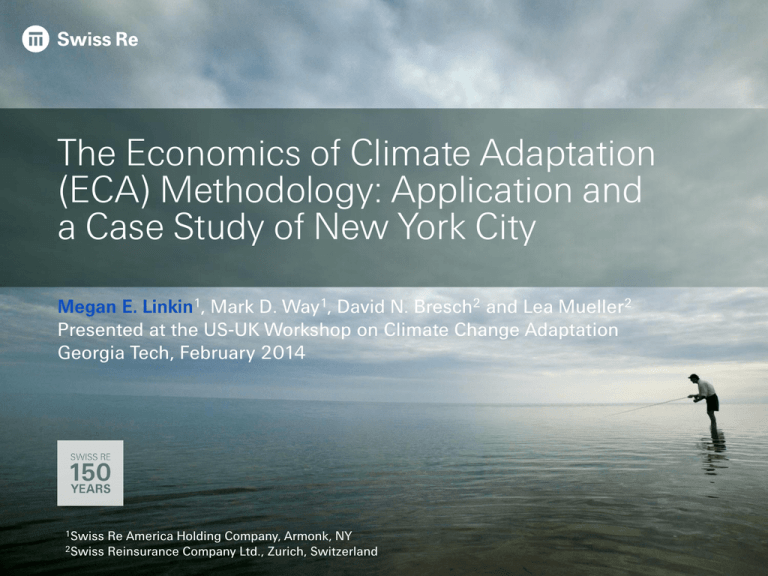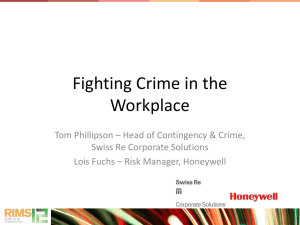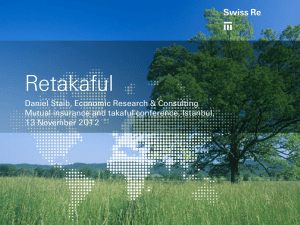
The Economics of Climate Adaptation
(ECA) Methodology: Application and
a Case Study of New York City
Megan E. Linkin1, Mark D. Way1, David N. Bresch2 and Lea Mueller2
Presented at the US-UK Workshop on Climate Change Adaptation
Georgia Tech, February 2014
1Swiss
2Swiss
Re America Holding Company, Armonk, NY
Reinsurance Company Ltd., Zurich, Switzerland
Introduction
M. Linkin, Swiss Re | 7 February 2014 | US-UK Workshop on CCA
2
Our interest in weather, climate and modeling
• Natural catastrophe risk is the core driver of the property reinsurance business.
• Our core business is natural catastrophe oriented
– It is important for us to understand risk completely as possible
• The historical record does not provide a large enough sample of events to determine
true or future hazard.
– Must rely on simulations of physically possible events not in the historical record to
understand risk landscape
• Real non-life premium growth in emerging markets expected to be near 8% in 2014
(Swiss Re).
– Enhanced understanding of extreme weather events in areas historically under-observed
• Climate change alters to the risk landscape through a variety in potential shifts in the
frequency and severity of events dependent upon hazard and region.
– Without shifts in storm frequency, sea level rise alone will change coastal flood probabilities
• Increasing demand for parametric insurance products which settle on event, not
loss, characteristics.
– Near real time deterministic model simulation is an event settlement option
M. Linkin, Swiss Re | 7 February 2014 | US-UK Workshop on CCA
3
Weather-Related Economic and Insured Losses
1970-2012 (2012 USD)
Source: Swiss Re Economic Research and Consulting
• Upward trend in magnitude of annual losses
–
Between 1970 and 1979, the annual average economic loss was USD 6.4 billion
–
Between 2000 and 2012, the annual average economic loss was USD 105.5 billion
• Increasing gap between total economic loss and insured loss
–
Between 1970 and 1979, 54% of the total loss was covered by insurance
–
Between 2000 and 2012, 37% of the total loss was covered by insurance
M. Linkin, Swiss Re | 7 February 2014 | US-UK Workshop on CCA
4
Cities at Risk
Swiss Re's Mind the Risk report
• Currently, 1.7 billion people (25% of global population) reside
in major metropolitan areas
• Major cities contribute USD 34 trillion, or 50%, to the global
GDP.
• New York City: Most storm-surge exposed US city, with 1.1
million people potentially affected by an extreme storm surge
event.
• The UN estimates that by 2050, 6.3 billion people will reside
in cities.
• High emissions scenarios from the IPCC AR5 predict a global
sea level rise of 52-98 cm.
–
Increased sea level will change the frequency of floods and storm
surges.
• Therefore, it is imperative that cities, states and nations
globally understand the risk posed by natural catastrophes,
how the risk landscape will change under climate change and
take the necessary steps to protect infrastructure, physical
structures and citizens.
Source: Swiss Re Catnet
M. Linkin, Swiss Re | 7 February 2014 | US-UK Workshop on CCA
5
Economics of Climate Adaptation (ECA)
Comprehensive Risk Assessment, from Hazard to Cost
• Assess total climate risk
– Today's climate risk
– Future climate change scenarios
• Using Swiss Re's proprietary
catastrophe models, current and
future hazards are translated to
economic loss potential
• Various resiliency strategies can be
implemented to demonstrate
savings of each measure
considered.
• Powerful tool to allow decision
makers to understand current and
future risk and benefit of long term
action
M. Linkin, Swiss Re | 7 February 2014 | US-UK Workshop on CCA
6
Swiss Re's proprietary model considers four elements that
determine natural catastrophe loss potential
Hazard
Vulnerability
How often / how
strong?
How well built and
protected?
Value
distribution
Cover conditions
What exactly is covered ...
where...
and how?
Sums insured
Example
Hurricane
“Charley”
Aug 2004
Cover limits
Deductibles
Exclusions
etc.
M. Linkin, Swiss Re | 7 February 2014 | US-UK Workshop on CCA
The working group studied 18
regions with diverse climate hazards
U.K. / Hull
New York
China
Mali
North, Northeast
US Gulf coast
Florida
India
Maharashtra
Anguilla, Bermuda,
Barbados , Jamaica,
Antigua and
Barbuda, St. Lucia,
Dominica
Tanzania
Samoa
Samoa
Guyana
www.swissre.com/climatechange
Economics of Climate Adaptation (ECA) Working Group, a partnership between the Global
Environment Facility, McKinsey & Company, Swiss Re, the Rockefeller Foundation, ClimateWorks
8
Foundation, the European Commission, and Standard
Chartered
Bank.2014 | US-UK
M. Linkin, Swiss
Re | 7 February
Workshop on CCA
The City of New York: A
Case Study
M. Linkin, Swiss Re | 7 February 2014 | US-UK Workshop on CCA
9
Hurricane Sandy
Facts and figures: Loss Estimates
Source: AON Benfield, PCS, FEMA
M. Linkin, Swiss Re | 7 February 2014 | US-UK Workshop on CCA
10
The Aftermath of Superstorm Sandy
New York
According to government officials:
• Residential damage is estimated at USD
9.7 billion, with over 100 homes burned in
Breezy Point.
• The MTA sustained USD 5 billion in damage
and lost revenue, with the South Ferry –
Whitehall St. station requiring USD 600
million to repair.
• Historic Rye Playland lost its log flume ride
and estimates USD12 million in damages.
Breezy Point, NY – October 30, 2012
Source: New York Daily News
• Total damages in New York City estimated
at USD 19 billion.
– USD 13 billion in physical damage
– USD 6 billion in lost economic
productivity
M. Linkin, Swiss Re | 7 February 2014 | US-UK Workshop on CCA
The Aftermath of Superstorm Sandy
New York
According to government officials:
• Residential damage is estimated at USD
9.7 billion, with over 100 homes burned in
Breezy Point.
• The MTA sustained USD 5 billion in damage
and lost revenue, with the South Ferry –
Whitehall St. station requiring USD 600
million to repair.
• Historic Rye Playland lost its log flume ride
and estimates USD12 million in damages.
Breezy Point, NY – October 30, 2012
Source: New York Daily News
• Total damages in New York City estimated
at USD 19 billion.
– USD 13 billion in physical damage
– USD 6 billion in lost economic
productivity
M. Linkin, Swiss Re | 7 February 2014 | US-UK Workshop on CCA
The NYC Special Initiative for Rebuilding and Resiliency
(SIRR)
• Created by Mayor Michael Bloomberg to address how to create a more
resilient New York City in the wake of Hurricane Sandy, with a long-term
focus on preparing for and protecting against the impacts of climate change
• A final report, released in June, presents actionable recommendations both
for rebuilding the communities impacted by Sandy and increasing the
resilience of infrastructure and buildings citywide.
Source: Iwan Baan Photography
M. Linkin, Swiss Re | 7 February 2014 | US-UK Workshop on CCA
13
The Economics of Climate Adaptation
Methodology for the City of New York
• Hurricane models: Swiss Re has built a probabilistic tropical cyclone model
based on robust historical data. Swiss Re uses data from the National
Hurricane Center that includes nearly 1,200 observed tropical storms and
hurricanes in the Atlantic Basin between 1891 and 2008.
• Climate change scenarios: The City provided Swiss Re with guidance on
projected sea level rise in the 2020s and 2050s, based on work of the New
York Panel on Climate Change (NPCC). Specifically, the City instructed
Swiss Re to assume of sea level rise by the 2020s, and the 2050s, based on
the NPCC’s climate projections. In addition, Swiss Re adjusted the future
frequency of different categories of hurricanes (tropical storm through
category 5) based on academic research.
• City-level asset and economic activity: The consultants worked closely with
City agencies to develop a working model of asset value divided into several
categories, including, among other things, buildings, transportation,
telecommunications, and utilities. These asset values were further broken
down by zip code as was the city’s economic activity (gross city product).
M. Linkin, Swiss Re | 7 February 2014 | US-UK Workshop on CCA
14
Swiss Re's Probabilistic Tropical Cyclone Model
•
Swiss Re uses HURDAT Best Track data set
from National Hurricane Center in Miami
(includes all tropical cyclones in Atlantic
Basin between 1851 and 2008)
•
Each historical track perturbed 199 times
via direct random walk process
•
200 tracks result in a track set containing
223,400 tropical cyclones
•
Holland model, coupled with a roughness
layer, produces a wind field for each track
•
SLOSH model, coupled to a digital
elevation model, calculates storm surge for
each track, using atmospheric pressure,
forward speed, size, angle of landfall, and
track data
•
Approach did not consider Nor’easters
M. Linkin, Swiss Re | 7 February 2014 | US-UK Workshop on CCA
15
Results
Loss Frequency Curve
Quantity
2013
2020s
2050s
USD 19
billion
70
years
60
years
50
years
70 year
return
period
loss
USD
19
billion
USD
35
billion
USD
90
billion
Source: A Stronger, More Resilient New York
M. Linkin, Swiss Re | 7 February 2014 | US-UK Workshop on CCA
16
Results
Annual Expected Loss (AEL)
• Average annual impact
to assets and GDP
• Some years will have a
single or multiple large
losses, other years will
be zero.
• Today: USD 1.7 billion
• 2050s: USD 4.4 billion
– USD 1.5 billion from sea
level rise
– USD 1.2 billion from
changes in storm
frequency
Source: A Stronger, More Resilient New York
M. Linkin, Swiss Re | 7 February 2014 | US-UK Workshop on CCA
17
Results
Annual Expected Loss by ZIP code
Source: A Stronger, More Resilient New York
• Current drivers of loss: east and south shores of Staten Island, southern Brooklyn and
Queens, Brooklyn and Queens waterfront and southern Manhattan.
• Under future scenarios: Same geographic regions, plus northern Queens and the
Bronx
• Under 2050s scenario: 400% increase in ZIP codes which have an AEL of USD 30
million
M. Linkin, Swiss Re | 7 February 2014 | US-UK Workshop on CCA
18
Results
Cost-Benefit Analysis
• Model can be used to
assess the financial
savings from various
mitigation efforts.
• Combining the
modeled savings with
cost estimates can
provide helpful
guidance for decision
makers when
selecting which
efforts to focus on.
• NYC decided to focus
on efforts where the
cost-benefit ratio was
less than 2.
Source: A Stronger, More Resilient New York
M. Linkin, Swiss Re | 7 February 2014 | US-UK Workshop on CCA
19
Concluding Thoughts
• Increases in population in urban areas requires cities have a comprehensive
understanding of risks posed by the current climate.
• Climate change is set to alter the risk landscape, and these changes coupled
with a continually growing population, necessitates planning for future risks
today.
• The ECA methodology developed by Swiss Re provides policy makers and
decision makers with an end to end risk analysis, from hazard to costs.
• The ECA methodology was successfully deployed for the City of New York,
and played an important role in shaping the City's fortification and
rebuilding plans.
M. Linkin, Swiss Re | 7 February 2014 | US-UK Workshop on CCA
20
Thank You
For more information regarding the ECA studies and the Mind the Risk
report, please visit
http://www.swissre.com/rethinking/climate_and_natural_disaster_risk/
To read the SIRR report A Stronger, More Resilient New York, please visit
http://www.nyc.gov/html/sirr/html/report/report.shtml
M. Linkin, Swiss Re | 7 February 2014 | US-UK Workshop on CCA
21
M. Linkin, Swiss Re | 7 February 2014 | US-UK Workshop on CCA
22
Legal notice
©2014 Swiss Re. All rights reserved. You are not permitted to create any modifications
or derivative works of this presentation or to use it for commercial or other public purposes
without the prior written permission of Swiss Re.
The information and opinions contained in the presentation are provided as at the date of
the presentation and are subject to change without notice. Although the information used
was taken from reliable sources, Swiss Re does not accept any responsibility for the accuracy
or comprehensiveness of the details given. All liability for the accuracy and completeness
thereof or for any damage or loss resulting from the use of the information contained in this
presentation is expressly excluded. Under no circumstances shall Swiss Re or its Group
companies be liable for any financial or consequential loss relating to this presentation.
M. Linkin, Swiss Re | 7 February 2014 | US-UK Workshop on CCA
23







